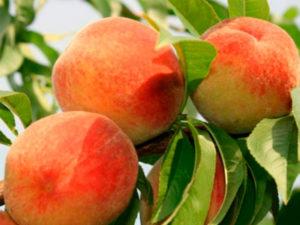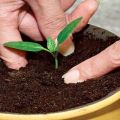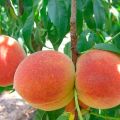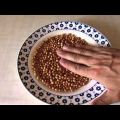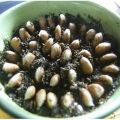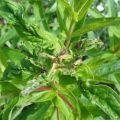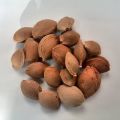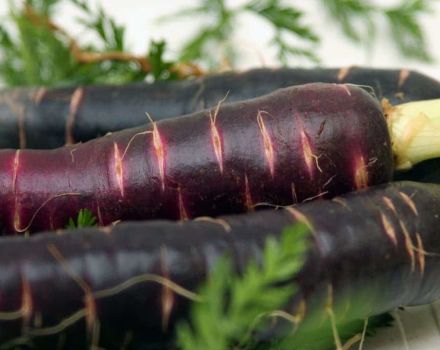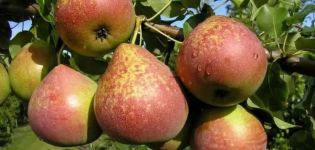How to plant a seed and grow a peach from it at home
Experimental gardeners are interested in how to grow a peach from a stone. Is it possible, after eating a delicious and fragrant fruit, then get the same in your garden from your trees? Some gardeners dare to experiment with growing fruit. For success, you should choose the planting material correctly, be patient. And then you just need to follow the recommendations of agronomists. It is worth noting that the southerner peach succeeds well in regions with a cool climate. So all gardeners can try to grow their own peach trees in the country.
Content
- 1 Pros and cons of growing a peach seed
- 2 Will a peach grown from a stone bear fruit
- 3 Which peach pits are suitable for planting
- 4 Seed germination methods
- 5 Seed growing technology
- 6 Caring for peach seedlings before planting in a permanent place
- 7 How to properly transplant a peach into open ground
- 8 Tree care
Pros and cons of growing a peach seed
This event has positive aspects:
- The gardener has already tasted the fruit and has an idea of its taste and texture.
- Bone propagation allows you to get as much planting material as required.
- Saplings are cheap: the grower can experiment with plant placement.
- Successful self-rooted peach trees provide abundant grafting material.
But it is important to remember about the negative aspects of the process:
- It will be possible to grow a tree with the taste of mother fruits only if the seed is taken from the variety. Hybrids do not convey the original qualities.
- Sometimes it is difficult to find the source material: the sprout gives seeds from the ripe ripe fruits.
- The process is long and laborious: an impatient gardener is unlikely to succeed.
And yet, summer residents grow peach trees from seeds and are proud of the harvest they receive.
Will a peach grown from a stone bear fruit
It depends on many factors. A tree will bear fruit if:
- The seed is taken from a fully ripe fruit. It is free from insect damage and has a whole shell.
- The peach tree from which the seed is taken is a variety, not a hybrid. The hybrid may also bear fruit, but their taste and quantity are unlikely to please the gardener.
- The place of planting of a young seedling is well chosen.The tree must be protected from cold northerly and northeasterly winds.
- Fertilizers were correctly applied when planting.
- The crown of the tree is well formed.
- The climatic features of the region are taken into account and correlated with the technical characteristics of the bone tree.
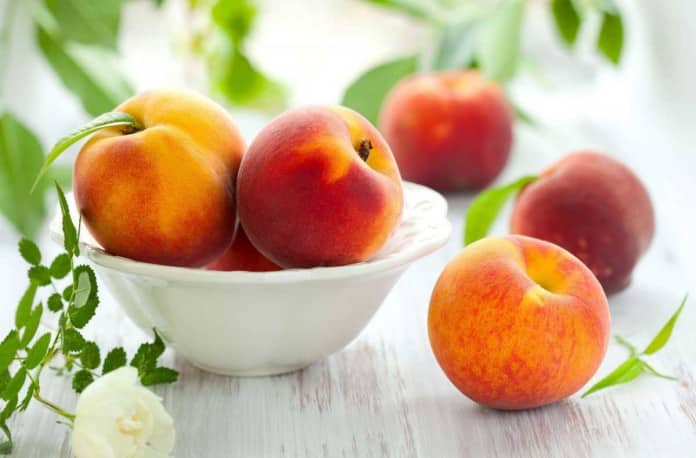
In order to always be with fruits, you need to take care of pollination. If the variety is self-fertile, then pollinating plants are not needed. Other varieties require peach trees to pollinate it. These are varieties or hybrids that bloom at the same time as the planted plant.
Which peach pits are suitable for planting
For planting, seeds from healthy peaches are selected. Fruits should be fully ripe, soft, with a whole skin, without dark spots. It is recommended to buy local fruit from the market to ensure that the fruit is ripe on the tree.
The original plant must be a variety: hybrids do not convey maternal qualities. This can also be obtained from the seller in the market.
The bone must be intact, free from insect damage and cracks. It is important to remember: easy separation of the bone from the pulp is a varietal feature, and not an indicator of the ripeness of the fruit.
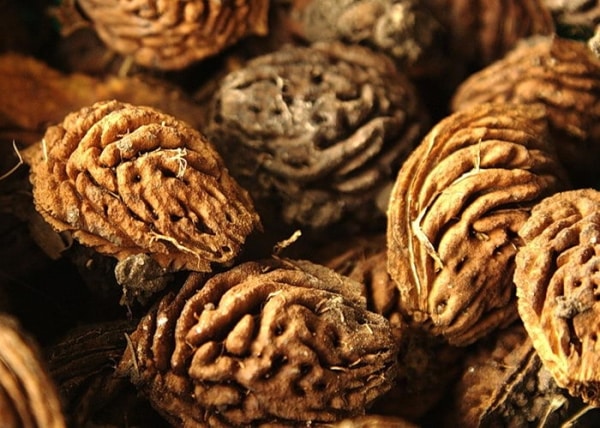
Seed germination methods
A tree can be grown from a seed in several ways. And the gardener can choose the one he likes. To obtain a positive result, you need to prepare the material. The seed must be carefully removed from the peach, being careful not to damage the shell. Then the bone should be washed with cold water.
The cleaned and washed raw materials should be dried at room temperature away from sources of heat and sunlight. If it is not possible to immediately plant a seed, it should be stored in a dark, cool place.
It is important to remember: about 40% of the seeds germinate, 20% of the seedlings die when transplanted to a permanent place in the garden, so you should stock up on a significant amount of planting material.
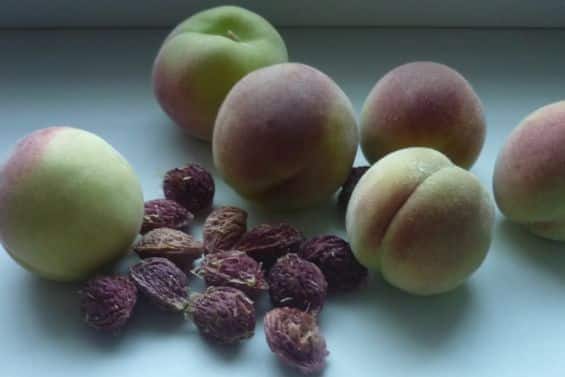
Stratification
The essence of the method is that stress conditions are artificially created for the seed, which accelerate germination and at the same time temper the plant.
How to proceed:
- prepare a substrate for stratification: neutral peat, sawdust, small wood chips, coconut flakes;
- pour the substrate into a bag or pot, make holes for gas exchange;
- place the bone inside a bag or pot, sprinkle it on top with a substrate;
- slightly moisturize;
- place in a refrigerator in a fruit compartment or cellar (the temperature for stratification should be within 5-6 degrees Celsius);
- moisten the substrate regularly.

After 3-4 months, the seed will sprout. It's time to transplant it into a pot for growing a seedling.
Extracting seeds
This method of growing seedlings accelerates seed germination. But at the same time, the likelihood of the death of the embryo increases due to a violation of the protective membrane (shell).
At a dry bone, the shell is carefully broken, the seeds are removed. In this case, the thin shell cannot be damaged. The seed is placed on a plate and covered with water (the liquid should only slightly cover the seeds). To accelerate germination, you can add aloe juice, potassium humate or a root formation stimulator to the water.
After a visible increase in the material, the seed is taken out of the water, placed in the ground, moistened, covered with a film on top with holes for air intake.
The container is placed in a warm place. The soil is regularly watered, condensation is removed from the film. After the sprout appears, the plastic is removed and the seedling is placed in a bright place, but away from direct sunlight.
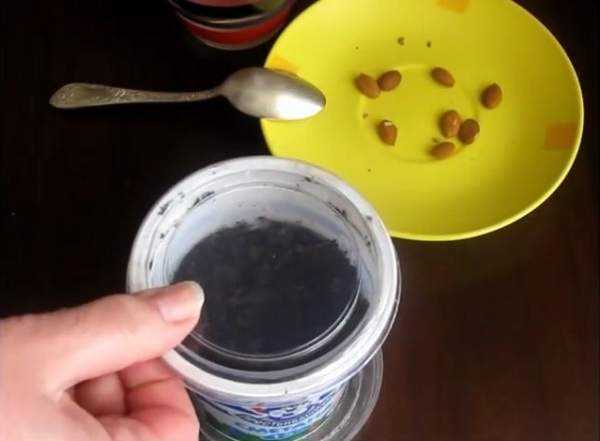
Warm way
The longest and least effective method. But it is suitable for growing a seedling at home. How to organize the process:
- dry bones must be stratified: placed in the fruit compartment of the refrigerator and kept there for 5-6 days;
- soak the bones in a growth stimulator (aloe juice, potassium humate, "Kornevin") for 3-4 hours;
- plant in the ground, deepening by 6-8 cm;
- moisten and cover with foil with holes for gas exchange;
- put in a warm place;
- regularly moisten the soil and remove condensation from the film.
After the sprouts appear, the containers should be placed in the light, but away from direct sunlight. The temperature should be 16-18 degrees Celsius.
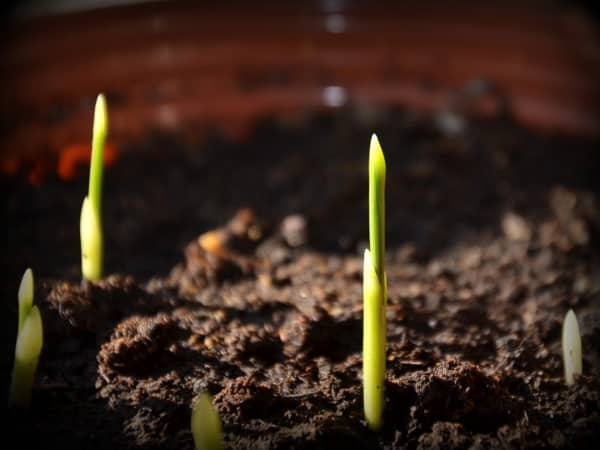
Seed growing technology
The number of seedlings received depends on how correctly the process is organized.
Tank and soil preparation
The containers must be thoroughly washed with a brush with hot water and soap or soda. Then dry it. If the gardener composes the soil on his own, then the components are recommended to be pre-frozen (to destroy pest larvae) and steamed (to destroy fungal spores). The finished soil does not need such procedures.
Pot dimensions and material
For germination, it is recommended to select containers made of plastic or clay. The former are lungs, and the latter allow air to pass through. The size of the dishes depends on the number of seeds. Depth - 30-35 cm.
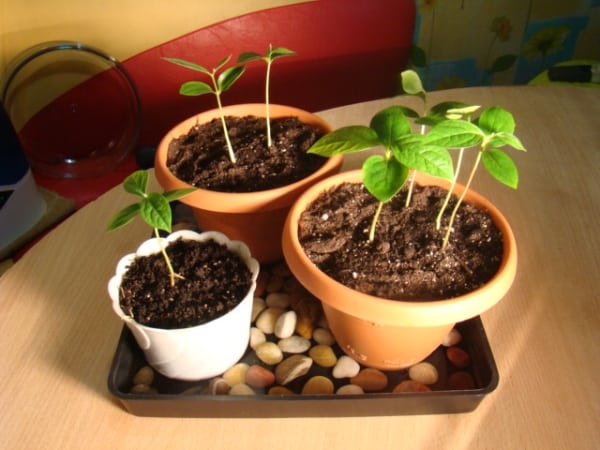
Soil composition
The soil should be light and moderately fertile: peat, sand, humus, sod land, sand in a ratio of 1: 1: 1: 2: 1. You can use a universal soil for flowering plants.
Drainage
The roots of a peach seedling easily rot when in contact with water. Therefore, on the bottom of the planting tanks, it is required to pour a drainage layer 1-2 cm thick. For this, broken brick, expanded clay, crushed stone are suitable. Before use, the drain must be scalded with boiling water and cooled.
Seed planting pattern and depth
The wide planting containers can accommodate several seeds. In this case, the seeds should be planted at a distance of 8-10 cm from each other. When the first true leaf appears, the seedlings are moved into separate containers, where they are grown until they are planted in a permanent place in the garden.

The seeds should be deepened 6-8 cm. At home, containers with sprouted seeds should be placed on light windowsills, protected from drafts.
When to wait for the sprout to sprout
The germination process is quite slow: seedlings when planting seeds in a warm way will delight the gardener in 3-4 months. When planting by stratification, 3-4 months will be required only when the material is kept in a cool place. But when planting with seeds extracted from the shell in 2-3 months, the seedling will reach a height of 50 cm.
Caring for peach seedlings before planting in a permanent place
To obtain strong seedlings for sprouted seeds, competent care is required. It will ensure success when planting trees in a permanent place in the garden.
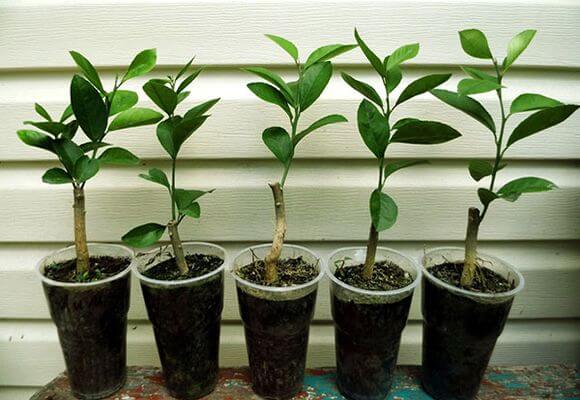
Daylight hours
For normal development, peach trees require intense lighting for 16-18 hours. It is recommended to use an agrolamp: it gives a spectrum that best matches sunlight.
Irrigation and feeding of the seedling
The soil in the pots should be moistened, but not overflown. Peach seedlings have an easily vulnerable root system. The plant is forced to exist in a limited capacity. For normal development, he needs good nutrition. It is recommended to feed the seedling every two weeks. In this case, the application of nitrogen and potassium-phosphorus fertilizers should be alternated.
You can use ready-made complex fertilizers for young fruit plants. In this case, you should feed according to the manufacturer's instructions.
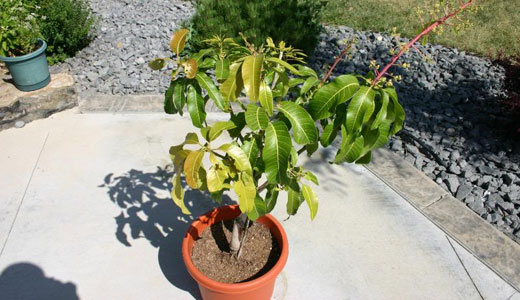
Optimum temperature
If a peach seedling lives in an apartment in winter, then it needs a temperature of 2-4 degrees. In the spring, the temperature rises to 18 degrees. With the onset of summer (if it is impossible to plant a plant in a permanent place in the garden), the peach needs a temperature of 25 degrees Celsius.
How to properly transplant a peach into open ground
In order for a seedling of a peach grown from a stone to take root well in the country, it should be properly placed in the garden. It is planted when the soil warms up enough and recurrent frosts have passed. 3-4 weeks before the intended landing in a permanent place, the tree begins to harden. It is put on a balcony or veranda, first for 20-30 minutes, then the time is increased. A few days before transplanting, the plant should be outdoors around the clock.
Recommended transfer times
The optimal time for planting in open ground is spring or early autumn. It is not recommended to place the plant too early (in March) outdoors. The seedling grown in the house has foliage and the nights are still cold this month. In spring, the ideal planting time is late April - early May.
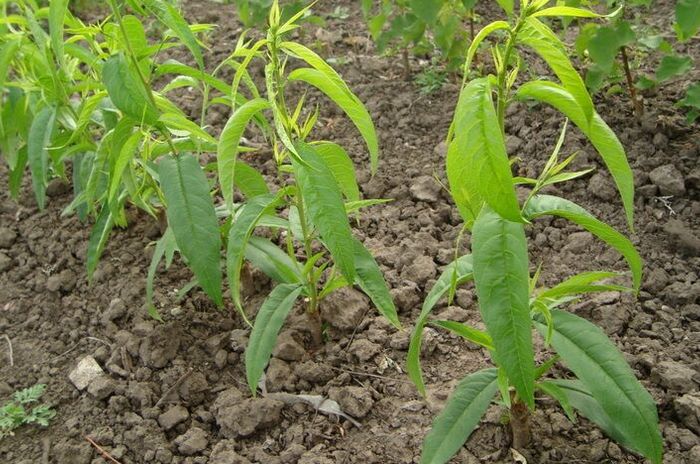
When planting in the fall, you need to take into account the time for the plant to take root. It will take 2-3 weeks to adapt in the open field. And the weather should be frost-free.
At what distance to plant
Peach trees are tall and have a wide crown. They need to be planted at a distance of 3-4 m from each other and from the walls of summer cottages.
Planting pit depth
A planting hole for a young peach must be prepared in advance: when planting in autumn - in spring, and when planting in spring - in autumn. The dimensions of the pit are 70 x 70 x 70 cm. The excavated soil is mixed with mature organic matter (bucket) and returned to the pit. Cover it with a sheet of plywood and leave before planting.
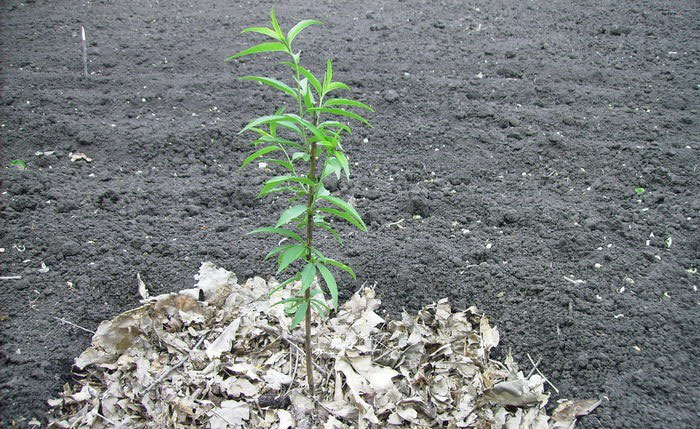
Required soil composition
A young peach requires light, fertile soil with a neutral or slightly alkaline reaction. If the soil is very acidic, it is recommended to deoxidize with dolomite flour, fluff lime or sifted furnace ash.
Heavy soil requires sanding, too light - clay. To do this, add a bucket of sand or clay per plant.
Algorithm of the procedure
For successful rooting of a seedling, proceed as follows:
- choose a cloudy day or time after sunset for landing;
- open the landing pit;
- form a planting hole (a place for free placement of peach roots);
- mix the removed soil with mineral fertilizers (phosphorus and potassium);
- form a small mound at the bottom;
- drive in a peg for a tree garter;
- place the roots of the plant on a mound;
- pour in the remaining earth;
- trample down the trunk circle;
- it is good to water and mulch the trunk circle;
- tie a peach to a peg with an eight;
- put a lutrasil screen to protect from direct sunlight.
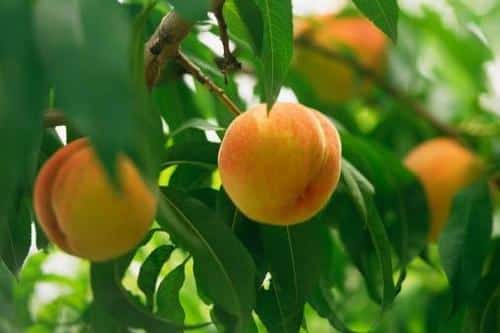
When the seedling starts up new leaves, remove the screen.
Tree care
To get a fast harvest, peaches need to be cared for properly.
Watering
A young seedling needs regular watering. But at the same time, it should be moistened only after the trunk circle has dried. With an excess of moisture, the roots of the plant rot.
Fertilizer
When planting using the planting pit, the first 3 years of fertilization are not required for the peach. Then fertilizer should be given 2 times a year: in spring, after leaving wintering, and in autumn (in September-October).
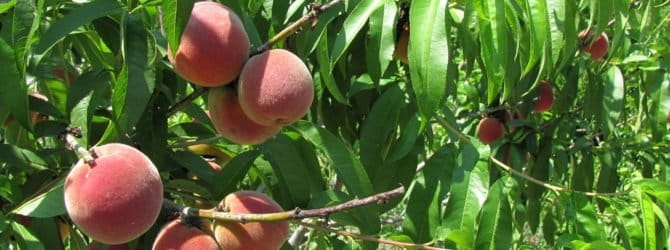
Trimming schemes and timing
Peach trees produce abundant growth. They should be cut in the spring (sanitary, thinning procedures) or in the fall (formative, sanitary).
It is important to consider: fruit buds are formed on the lateral shoots, therefore, during formative cutting, the central conductor must be constantly shortened. This will stimulate the growth of the side branches and make it easier to care for the tree.
Treatment against pests and diseases
To prevent diseases, it is recommended to carry out preventive spraying. The first is done in early spring. Then - on schedule. At the same time, weeds should be weeded out, anthills should be removed, and plant residues should be burned.
Shelter for the winter
Only in regions with positive average winter temperatures can peaches winter without shelter. In other places, the trunk circle should be mulched with peat, sawdust, shavings 20-25 cm thick.It is recommended to tie the trunk with spruce branches or mineral wool. This measure will protect the plant from damage by hares.
To prevent freezing and cracking of wood on the north and north-east sides, it is recommended to install a screen made of plywood, slate or plastic. It will protect you from cold winds.

